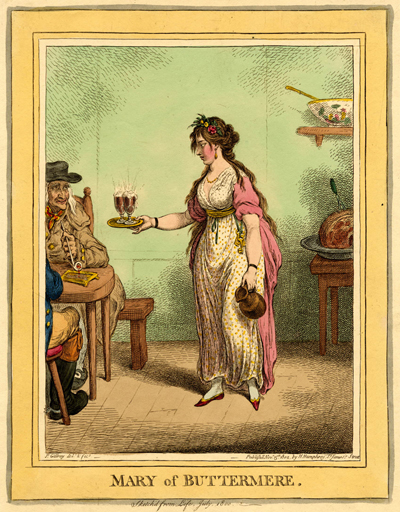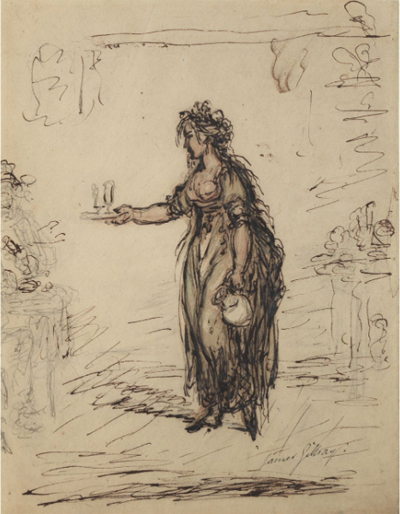Mary of Buttermere
This charming print shows a non-caricatured Mary Robinson, serving a pair of frothing drinks to two patrons in her father's inn at Buttermere. Her hair is long and thick and ornamented with natural flowers. Behind her is a punch bowl and a roast. As the notation below the title suggests, the print is based on a sketch by Gillray (now part of the collection of Dove Cottage and the Wordsworth Trust) made in July 1800 on a visit to Buttermere.* At that time, Mary would have been 22 years old.

© Trustees of the British Museum

© By Permission of The Wordsworth Trust
For the previous eight years, Mary had become something of a celebrity in the Lake District as a result of the notice paid to her by "The Rambler" (i.e. Captain Joseph Budworth) in his travel log, A Fortnight's Ramble to the Lakes in Westmoreland, Lancashire, and Cumberland (1792).
Discussing the village and its inhabitants, Budworth described his visit to the Inn at Buttermere and his first sight of the innkeeper's daughter, whom he called Sally in the first two editions of his Fortnight's Ramble.
Her mother and she were spinning woolen yarn in the back kitchen; on our going into it, the girl flew away as swift as a mountain sheep, and it was not until our return from Scale Force that we could say that we first saw her; she brought in part of our dinner, and seemed to be about fifteen. Her hair was thick and long, of a dark brown, and though unadorned with ringlets, did not seem to want them; her face was a fine contour with full eyes, and lips as red as vermillion; her cheeks had more of the lily than the rose; and although she had never been out of the village, (and I hope will have no ambition to wish it) she had a manner about her which seemed better calculated to set off dress then dress her. She was a very Lavinia, 'seeming when unadorn'd, adorn'd the most.' When we first saw her at her distaff after she had got the better of her first fears, she looked an angel, and I doubt not but she is the reigning lily of the valley.
Budworth's account aroused the curiosity of travelers to the Lake District, two of whom—William Wordsworth and Samuel Taylor Coleridge—visited the Inn at Buttermere together on November 11, 1799. Wordsworth later celebrated "the Maid of Buttermere" in Book VII of his autobiographical poem, The Prelude. And Coleridge was impressed enough with her grace if not her beauty, that he seems to have become the local source of information for London newspapers about Mary's subsequent history.
Gillray would have had many opportunities to hear about the book and hence about the Maid of Buttermere. Between 1792 and 1795, advertisements of Budworth's Fortnight's Ramble had appeared in numerous London newspapers such as the Star, St James Chronicle, and the Times. And in 1795 a second edition was issued "With Additions and Corrections". But it was not until January 1800, when Budworth published "A Rambler's Re-visit to Buttermere in The Gentleman's Magazine Vol.LXX that he correctly identified the innkeeper's daughter as Mary not Sally. In that article he also qualifies his praise of her beauty: "Mary Robinson has really a heavenly countenance, yet she is far from a perfect beauty; and in a few years she may even grow too large ever to have been thought what she now is."
But though the combination of book and article may have prompted Gillray's visit to Buttermere and the sketch of Mary in July 1800, it was not what prompted Gillray's published print. The impetus for that was a series of articles in Morning Post Gazetteer and the London Star beginning in October 11, 1802 under the heading of "Romantic Marriage."
On the 2d instant a Gentleman, calling himself Alexander Augustus Hope, Member for Linlithgowshire, and brother to the Earl of Hopetown, was married at the church of Lorten, near Keswick, to a young woman, celebrated by the tourists under the name The Beauty of Buttermere.
It seemed like a fairy tale ending for a country girl who was as well known for her "irreproachable character" as her grace and beauty. But alas, it was too good to be true. By October 15, the seemingly noble suitor was shown to be an impostor and a thief and had disappeared from the area. And by October 30 (as reported in the London Star), a costly dressing box which he had, in his hasty departure, left behind was discovered to have a false bottom containing letters from his wife and children, proving that he was a bigamist. The article concludes with: "Poor Mary is the object of universal concern."
Given this amount of publicity, it is not surprising that Gillray would have resurrected his sketch and given a face and figure to this sad story. And I can't help but think that the real context of the story helps explain the lack of caricature in the print, the slightly subdued expression on Mary's face, and the look of compassion from the sitting patron.
NOTE: For the rest of Mary's story and the real identity of her suitor, see the article from the Dove Cottage site.
* Thanks to Tim Clayton for pushing me in the direction of the Wordsworth Trust for information about Gillray's visit to Buttermere.
Sources and Reading
- Commentary from the British Museum on Mary of Buttermere.
- A Fortnight's Ramble to the Lakes in Westmoreland: Lancashire, and ...
- "Revisit to Buttermere," An Appendix to A Fortnight's Ramble to the Lakes in Westmoreland: Lancashire, and ...
- "Mary Robinson (Maid of Buttermere)," Wikipedia
- "The Maid of Buttermere," Dove Cottage & The Wordsworth Museum
- "John Hatfield (forger)," Wikipedia
- Draper Hill, Mr. Gillray The Caricaturist, 1965, p. 88.
- Thomas Wright and R.H. Evans, Historical and Descriptive Account of the Caricatures of James Gillray #522.
- Thomas Wright and Joseph Grego, The Works of James Gillray, the Caricaturist; With the History of His Life and Times, p. 290
Comments & Corrections
NOTE: Comments and/or corrections are always appreciated. To make that easier, I have included a form below that you can use. I promise never to share any of the info provided without your express permission.